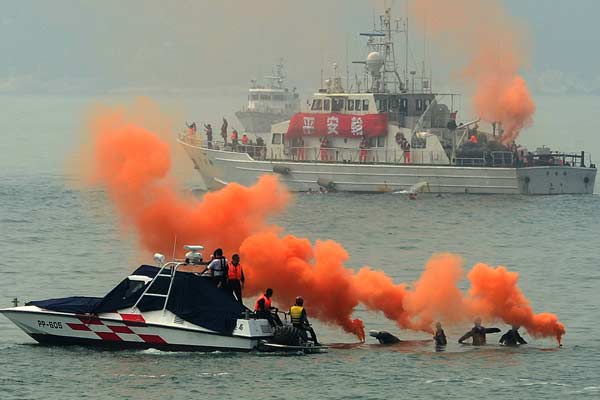
?Authorities from the mainland and Taiwan launched a massive sea search and rescue drill on Thursday in the Taiwan Straits, aiming to ensure safe transport on waterways across the Taiwan Straits.
| ?
 Dummy “passengers” drop orange smoke grenades into the water to call for help during a joint sea search and rescue drill between the mainland and Taiwan in the Taiwan Straits on Thursday. Zhang Renfeng / For China Daily |
The drill, the largest of its kind since it was first held two years ago, took place in the waters between Fujian’s Xiamen and Taiwan’s Kinmen.
Two helicopters, 14 rescue vessels and more than 300 professional rescue workers participated in the drill, and the mainland and Taiwan were equally represented.
The drill started around 10:30 am under a simulation scenario that an airplane from Taipei to Xiamen was forced to land in the sea due to engine trouble, sideswiping a passenger ship that later caught fire and causing two fishing boats to overturn.
Rescue ships from the mainland and Taiwan rushed to the scene after the two sides shared information about the "incident". Lifeboats and motorboats were dispatched to search and rescue "passengers", or inflatable dummies, in the sea.
Rescue workers also descended from helicopters to save passengers, and experienced divers searched for "fishermen" trapped in the overturned fishing boats.
Salvage ships used hoses to put out a fire on the passenger ship, and a tugboat pulled the wrecked plane to safe waters.
The drill lasted about 40 minutes, and all of the scheduled tasks were successfully completed.
"Such exercises test and improve the ability to help save lives and property in sea accidents across the Taiwan Straits," said Zhai Jiugang, deputy director of the Maritime Safety Administration, the country’s water safety supervisor.
Zhai said that the mainland and Taiwan have already set up a 24-hour liaison system to report sea accidents for rescue cooperation in the Straits.
Zhai added that the mainland and Taiwan recently agreed to launch sea search and rescue drills every other year as regular training, and more academic exchanges on sea rescue will be made between the two parties.
He Yipei, head of the Fujian Maritime Safety Administration, said this year’s drill focused on the rescue of airplanes and passenger ships because of the increasing number of vessels in the sea and air across the Straits.
"The volume of both travelers and goods are on the rise, therefore more efforts have to be made to meet increasing demands of safer cross-Straits transport," He said.
The number of passengers traveling by boat between the mainland and Taiwan has increased since 2001, when a mechanism known as the "mini three links" was set up, which allows direct ferry services between coastal cities in Fujian province and Taiwan’s offshore islands Kinmen, Matsu and Penghu.
Statistics show that people from the mainland and Taiwan made more than 1.38 million trips across the Straits through the sea link in 2011, with about 4,000 travelers taking the ferry service a day on average.
In the first half of this year, the number of travelers on the sea across the Straits increased by 13.6 percent compared with last year.
In 2008, the two sides agreed to direct flights between the mainland and Taiwan, which now has more than 550 flights in a week across the Straits, but that also increased the probability of airplane accidents on the sea, Zhai said.
The mainland’s Association for Relations Across the Taiwan Straits and the Taiwan’s Straits Exchange Foundation signed a maritime shipping agreement in November 2008, pledging to establish a cooperation mechanism for maritime rescue.
Statistics show that the Fujian maritime search and rescue center organized 209 rescue operations in the Taiwan Straits in 2011, assisting 193 ships in distress and helping 1,973 passengers.
Contact the writers at
tanzongyang@chinadaily.com.cn and sunli@chinadaily.com.cn